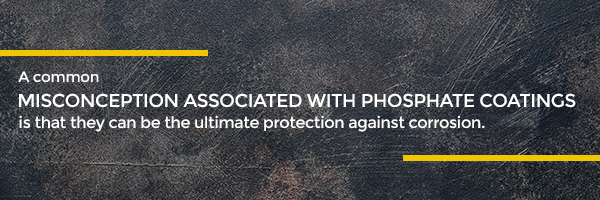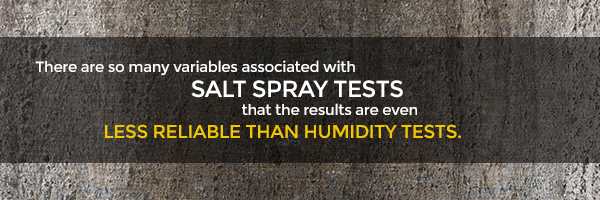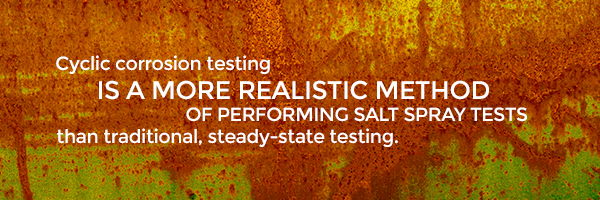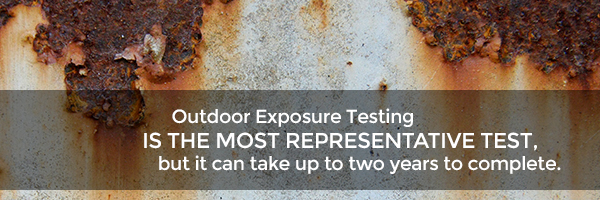Rust can wreak havoc on metal, so corrosion testing is a common practice for most companies that are heavy users of metal in their manufacturing processes.
Over the years, a number of testing protocols have been developed, including cyclic corrosion testing, salt spray testing, humidity testing, Kesternich chamber testing and specialized tests that accurately mimic specific conditions for designated platings, such as chrome, nickel, copper and others.
*Please note that Sharretts Plating does not plate with chrome. This content is for educational purposes only.
These and similar tests help manufacturers minimize or avoid rust by identifying the point at which corrosion begins to occur during the manufacturing process. Armed with this knowledge, companies can install the right protective measures into their production processes.
Electroplating can be an effective way to prevent rust — the key is to use the right plating method and materials. SPC offers a variety of industrial plating services that prevent rust, including a zinc-nickel plating process that’s a popular choice among automotive manufacturers because of its ability to prevent white and red rust from forming during salt spray testing (see Salt Spray testing below).
Let’s take a look at some of the industries that employ electroplating, the types of electroplating used to protect or otherwise enhance their products, and some of the more common corrosion testing methods used to provide early rust warnings.
Industries That Employ Electroplating
Electroplating is a commonly used tool in a wide variety of industrial applications. Here’s a sampling of some of those industries.
Automotive Plating
Most people who’ve owned vehicles have experienced rust, and automakers are constantly on the lookout for new and better ways to protect their products. Popular among automotive manufacturers today is a zinc-nickel plating solution that inhibits the formation of rust externally and on internal parts, including catalytic converters and plastic parts.
Electronics Plating
Gold plating is often used in the electronics industry because it provides levels of electrical conductivity and resistance to corrosion required by electronics, including semiconductors and connectors. Copper plating is a less expensive option than gold for circuit boards and other parts.
Alloys with mixes of palladium-nickel and palladium-cobalt provide effective protection for cell phones, personal computer batteries and other electronic devices.
Medical Equipment Plating
Among other benefits, plating is used to improve biocompatibility and improve corrosion resistance in medical devices. At SPC, precious metals such as gold, silver, and platinum series metals are used to plate medical equipment.
Tin is often used to coat tungsten and lead components in MRI units. Titanium parts used for joint replacements are also coated.
Aerospace Metal Plating
The high strength-to-weight ratio of titanium makes it a common manufacturing material in the aerospace industry. Nickel and copper electroplating provide superior protection against corrosion and wear. Copper electroplating can also be applied in heat treatment applications.
Testing Methods and Myths for Plated Parts
A common misconception associated with phosphate coatings is that they can be the ultimate protection against corrosion. What they are effective at is enhancing the performance of organic coatings, like paint and oil. They also improve the rust-proofing effectiveness of waxes and drawing compounds. This is not to say phosphates don’t provide any corrosion protection at all — just not the level of protection offered by other coatings.
Coatings failure can take up to six months to occur, and by then it’s too late to take protective action. For this reason, accelerated testing methods are available to assess relative corrosion effectiveness in a matter of days or weeks.
But beware — accelerated corrosion testing is only an indicator of the onset of corrosion, and may not be reliable under certain conditions. Why? There are numerous variables involved in every corrosion test, and any of them can taint the results if the test is not controlled.
For example, it’s not unusual to see wide disparities in results on parts from the same coating system that have been coated with different paints. More specifically, using a humidity test as an example, one type of paint might deteriorate in a 24-hour period, while another might last 2,000 hours. And that doesn’t even take into consideration such variables as differences in the method of paint application.
So, controlling the production painting process is important. Here are five keys that determine the performance level of painted parts:
- The time it takes to bake the paint
- The temperature setting for baking the paint
- The viscosity of the paint being baked
- The thickness of paint being applied to the metal
- The post-baking time allowed for the paint to cure
Temperature and bake time are most important. Curing paint consists of a chemical reaction that results in a change to the paint’s form. If the proper temperature and bake time are not applied, the desired end-result — a quality paint coating — will be compromised. As well, viscosity changes as atmospheric pressure and humidity change, and poor viscosity impacts paint spreadability and quality of coverage — a thicker coating offers better protection than a thinner coating.
Curing time is also important. This is the time needed to complete the polymerization of the paint, resulting in the final product.
Humidity Testing
The humidity test is one of the most reliable tests for gauging corrosion resistance, because of the correlation with field performance and the absence of controllable variables. Still, the results are relative because there are so many variables to control.
A typical humidity test cabinet is airtight and moisture-proof and features a top that slopes to one side. The sloped design directs the condensation that collects on the top to run down the side of the cabinet, instead of raining down on the parts being tested.
In a humidity test, the temperature is set at 100 degrees Fahrenheit, with acceptable variations of 2 degrees, plus or minus, with a relative humidity of 100 percent. Moisture can be introduced into cabinets through fogging. It can also be added by circulating a small fan inside a cabinet equipped with a reservoir filled with distilled (or de-ionized) water. These are called recirculating humidity cabinets.
More commonly, however, are cabinets that contain reservoirs but do not circulate the moisture. These condensing cabinets cause the moisture to break down earlier, because they collect more water than recirculating cabinets. In most cases, the panels to be tested are placed on a rack inside the cabinet. The panels are placed at angles of 15° to 30° off vertical, so the panels receive equal amounts of condensation — at least on one side. The upward side is then observed for failure.
The off-vertical angle is a key requirement that is often overlooked, resulting in non-reproducible results. Another variable that should be noted is condensation. It doesn’t exist equally in all areas of the cabinet. The amount of condensation varies by the construction of each unit.
Salt Spray Testing
There are so many variables associated with salt spray tests that the results are even less reliable than humidity tests. The overall appearance is similar, except that salt spray cabinets are larger than humidity cabinets. With salt spray cabinets, there is a trough filled with water that wraps around the perimeter of the top lip where the lid prevents the salt fog from escaping. It works like this:
Water is added into a saturator tower and then transported by air and blown out through a nozzle located inside the cabinet. The nozzle is mounted on a siphoning valve, which aspirates a salt solution from a reservoir.
The salt solution is then mixed with the incoming water-saturated air, producing a salt fog in the cabinet. The fog is collected in a flask and tested according to the desired concentration.
At first, tests using a 20 percent salt solution were considered adequate, but a 5 percent solution is a more rigorous test and has become the industry-standard test among metal finishing companies. This is because the salt’s chemical activity increases as the volume of water increases.
When conducting salt spray tests, be sure the salt is free of iodine and that the proper pH is produced when it’s mixed with distilled water or de-ionized water. Some time ago, ASTM specifications were revised to incorporate automatic water level controls and to relocate the fogging nozzle to a tower located in the center of the salt spray cabinet to improve salt fog distribution. Previously, the nozzle was located near the bottom and at one end of the cabinet.
The salt solution in the reservoir should be freshened every 48 hours, and the cabinet should operate continuously at 95 degrees, plus or minus 2 degrees. It’s apparent that, even before variables associated with preparing and observing the panels are considered, there are numerous factors that influence the cabinet’s performance: water level, air pressure, pH level, location of the fogging nozzle and its cleanliness, how frequently the salt solution is refreshed, the type of salt being used, the concentration of salt solution and the cabinet temperature.
When preparing painted panels for testing, the paint film is scored with an X. By the book, this should be done using a special scribing tool, a knife or some other sharp instrument. Watch out, though, because a dull scribing instrument can result in ragged edges in the paint, effectively increasing the amount of moisture in the area around the scribe. If the tool is too sharp, there won’t be enough moisture for a reliable test result. The angle of the scribing tool and the pressure applied when using the tool can also influence the test result.
You’re looking for some specific tell-tale signs when you remove the test panels from the cabinet:
- Blisters measuring 1/8-inch in diameter or more.
- Rust creepage from the scored line, or blisters measuring 1/8-inch or more.
The formation of rust along the edges is usually ignored, because the paint thickness in this area is not consistent — it’s often significantly thinner than the coating on the on the main surface. An effective way to treat the issue of rust along the edges of the panels is to apply wax to the edges.
How you inspect the panels has a direct impact on the results of the test:
- The panels should be inspected as soon as they are removed from the cabinet — as you would for a humidity test.
- Rinse panels vigorously with hot running water, or with gently-running cold water.
- After rinsing, blow compressed air (40 psi) at the score line via a needle-type nozzle. Hold the nozzle very close to the panel. The distance between the nozzle and the score line, along with the angle of the nozzle when delivering the compressed air, can impact the quality of the test.
Cyclic Corrosion Testing
This is another type of salt spray testing, and one that doesn’t rely on steady-state exposures. Atmospheric exposures often include both wet and dry conditions, so it’s logical to model laboratory tests after these natural cyclic conditions. Research indicates that, with cyclic corrosion tests, the relative corrosion rates, structure and morphology are more similar to those seen outdoors.
As a result, cyclic tests deliver better correlation to outdoor conditions than conventional salt spray tests. They are great for evaluating galvanic and crevice corrosion, among others.
Cyclic corrosion testing is a more realistic method of performing salt spray tests than traditional, steady-state testing. Because actual atmospheric exposures usually include both wet and dry conditions, it makes sense to pattern accelerated laboratory testing to be consistent with these conditions. Research shows that corrosion rates achieved with cyclic corrosion tests are consistent with outdoor conditions.
Cyclic corrosion testing can be used to evaluate a wide range of corrosion types, but is particularly effective with galvanic and crevice corrosion.
Immersion Testing
Immersion tests involve submerging the painted panels in water for a certain period of time and looking for early signs of blistering, similar to the humidity testing described earlier. The most common approach is to submerge the panels in distilled or de-ionized water that is kept at 95 to 100 degrees Fahrenheit. Some variations include:
- Using tap water, although distilled and de-ionized water have better penetrating ability, resulting in more severe test environments.
- Submerging only half of the panel and observing the condition where the panel meets the water.
- Varying the water temperature by 70 degrees to about 212 degrees.
- Immersing the panels in water mixed with various chemicals, or in solvents.
Outdoor Exposure Testing
This is the most representative test, but it can take up to two years to complete. That’s because the paint coating is allowed to cure completely — under normal conditions with variations in temperature, humidity and precipitation.
One of the most common test locations in the United States is the coast of Florida, where panels receive plenty of heat, moisture and salt. In these tests, panels are placed at an angle on racks similar to salt spray and humidity tests.
Abrasion Testing
The equipment required to conduct this test is expensive, so it’s less common among smaller industrial plating companies than some other physical adhesion-type tests. The equipment includes a jig to hold the panels and a rotating grinding wheel that’s mounted on a pendulum. The pendulum is attached to an instrument used to adjust its height.
The wheel rocks back and forth over the painted panels until the paint begins to chafe. The final test result involves correlating how far the pendulum was lowered with the width and length of the chafing.
Conical Mandrel Testing
This test involves a steel cone that’s mounted on a stand in a horizontal position. The cone narrows from approximately 2 inches in diameter at one end to about l/4-inch at the other. A steel bar runs along the cone’s length and is adjusted slightly — just a fraction of an inch — from the surface of the cone, and can be moved around, but always in a parallel and lengthwise position. The panel that’s being tested is held in a fixture alongside the cone, and is bent to conform to the shape of the cone by the steel.
What you’re looking for here are fractures in the paint. The width of a fracture is measured against its distance from the small end of the cone. As the panel is shaped to the cone, paint breaks that form at the point of the largest radius of curvature yield reliable intelligence about the paint and the phosphate coating that sits under the paint.
Avoid Corrosion With SPC, Your Reliable Metal Finishing Company
For more information about precious metal plating and how it can help you produce corrosion-resistant products, contact SPC to speak with one of our industrial plating service consultants. Alternately, fill out a brief form to get a free, no-obligation quote from our website.








